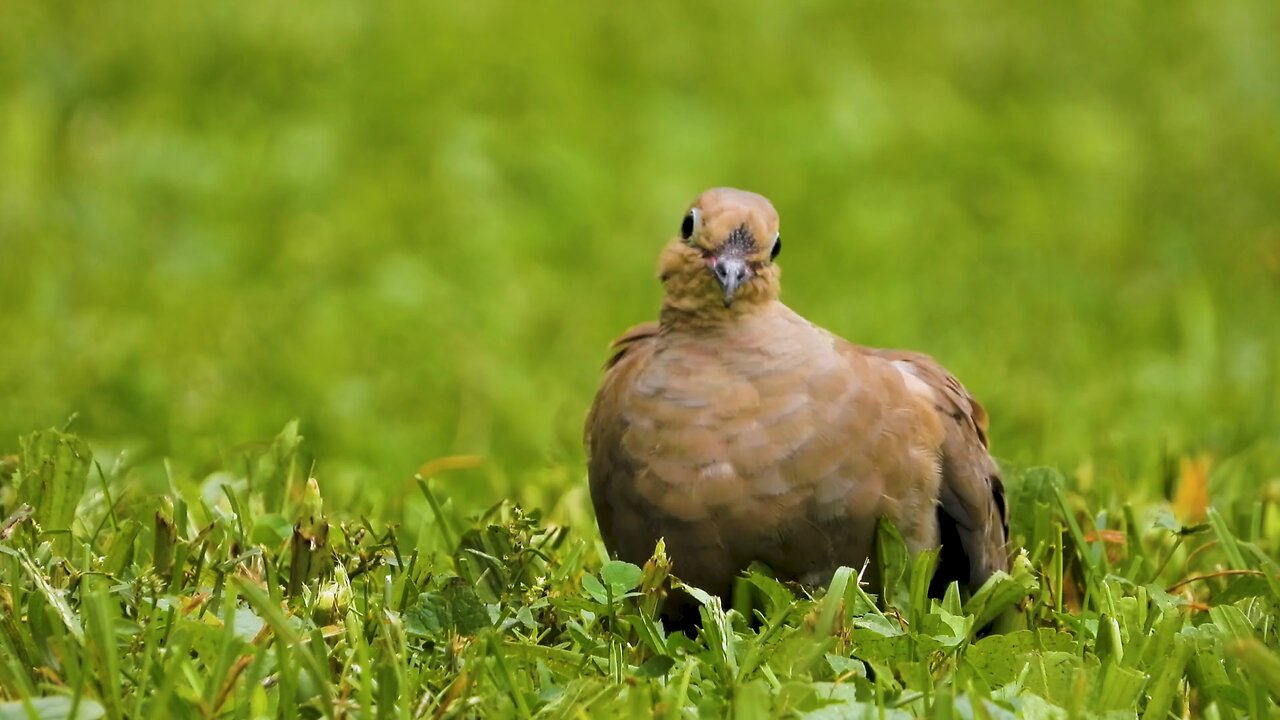Premium Only Content

"The Peaceful Presence of Mourning Doves"
The bird in your image appears to be a Mourning Dove (*Zenaida macroura*), a species widely recognized for its gentle nature and soft, mournful call. Here’s a more detailed description:
### **Physical Characteristics:**
- **Size and Shape**: Mourning Doves are medium-sized birds, typically around 9 to 13 inches (23 to 34 cm) in length, with a wingspan of about 17 to 18 inches (43 to 45 cm). They have a slender, streamlined body, a small head, and a long, tapered tail with white edges.
- **Plumage**: Their overall coloration is light grayish-brown, with subtle hints of pink on the chest and underparts. The wings have black spots, and the tail has white edges that are particularly noticeable during flight. Their eyes are dark, and they have a distinctive, delicate blue-gray eye-ring.
- **Bill and Feet**: The bill is relatively small and dark, while their legs and feet are a pinkish-red color.
### **Behavior:**
- **Feeding**: Mourning Doves primarily eat seeds, making them granivores. They forage on the ground in open areas such as fields, gardens, and lawns, where they feed on a wide variety of seeds, including those from grasses, weeds, and cultivated grains. They have a high metabolic rate, and it’s common for them to consume up to 20% of their body weight in seeds daily.
- **Flight**: Their flight is swift and direct, with strong wingbeats. Mourning Doves are also known for making a characteristic whistling sound with their wings when they take off, which is thought to be a form of communication or a way to startle predators.
- **Vocalization**: The mourning dove's call is a soft, mournful "coo-ah, coo, coo, coo," which is often mistaken for an owl's hooting. This call is used by males to attract a mate or to establish territory.
### **Habitat and Distribution:**
- **Range**: Mourning Doves are widespread across North America, including in Canada, the United States, and Mexico. They are highly adaptable and can be found in a variety of habitats, from rural farmland to urban gardens and parks.
- **Nesting**: These birds build simple nests, usually in trees, shrubs, or sometimes on the ground. The nests are often flimsy and constructed with twigs and grass. Mourning Doves typically lay two white eggs, and both parents take turns incubating them.
### **Reproduction:**
- **Breeding Season**: Mourning Doves are prolific breeders, often raising several broods per year, especially in warmer climates. The breeding season usually begins in early spring and can continue into the fall.
- **Parental Care**: Both parents are involved in caring for the young. After hatching, the chicks (called squabs) are fed "pigeon milk," a nutrient-rich secretion produced by the parents. The squabs grow quickly and are usually ready to leave the nest in about two weeks.
### **Conservation Status:**
- Mourning Doves are abundant and not considered threatened. They are one of the most common and widespread bird species in North America, with an estimated population of 350 million individuals. Their adaptability to different environments has helped maintain their numbers.
### **Cultural Significance:**
- Mourning Doves have been a symbol of peace and love in many cultures. Their soft, cooing calls and gentle demeanor make them a favorite among birdwatchers and nature enthusiasts.
This species is a wonderful example of a bird that has successfully adapted to human-altered landscapes while maintaining its natural behaviors and characteristics.
-

Nobodies Gaming
6 hours ago $3.67 earnedNobodies : Rumble Gaming MARVEL RIVALS
40.3K5 -
 24:08
24:08
MYLUNCHBREAK CHANNEL PAGE
1 day agoUnder The Necropolis - Pt 4
62.1K20 -
 19:52
19:52
Adam Does Movies
3 hours ago $0.12 earnedEmilia Pérez Movie Review - It's Uniquely Awful
8.93K1 -
 20:07
20:07
BlackDiamondGunsandGear
9 hours agoSPRINGFIELD ECHELON COMPACT / NOT GOOD
21.1K3 -
 DVR
DVR
Man in America
9 hours agoThe Terrifying Truth Behind Chemical Fog, Wildfire Smoke & Chemtrails w/ Dr. Robert Young
9.37K6 -
 LIVE
LIVE
Tundra Tactical
2 hours agoSHOT Show 2025 Wrap Up!! On The Worlds Okayest Gun Live Stream
191 watching -
 LIVE
LIVE
Right Side Broadcasting Network
1 day agoLIVE REPLAY: President Donald J. Trump Holds His First Rally After Inauguration in Las Vegas - 1/25/25
5,143 watching -
 2:55:24
2:55:24
Jewels Jones Live ®
1 day agoWEEK ONE IN REVIEW | A Political Rendezvous - Ep. 107
90.1K36 -
 1:33:29
1:33:29
Michael Franzese
1 day agoTrump Wastes No Time: Breaking Down Trump’s First Week Executive Orders | LIVE
107K89 -
 1:26:44
1:26:44
Tactical Advisor
12 hours agoTrump Starting Strong/Shot Show Recap | Vault Room Live Stream 015
77.9K8